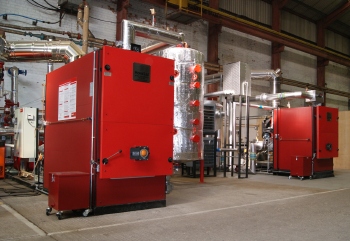Biomass heating that continues to perform

When designing heating systems that include biomass it is essential to consider factors such as fuel quality and maintenance requirements from the very early design stages. Martin Murrish of Hoval reviews the key considerations
Recent statistics relating to the deployment of renewable heat sources and uptake of the Renewable Heat Incentive (RHI) have confirmed that biomass continues to be the dominant choice in the UK. Consequently, given that RHI payments are based on the amount of heat generated, it is essential that biomass installations are reliable if predicted returns on investment are to be realised.
This requirement has serious implications for specifiers, as decisions made at the design stage of a project will have a significant impact on the ongoing reliability of biomass systems and their life-cycle costs. Of particular importance are the type of biomass fuel to be used and the ongoing maintenance requirements.
Choosing the most suitable type of biomass fuel for the project needs to be one of the first decisions, as this will influence every stage of the design. While biomass boilers themselves can be multi-fuel, the overall system is generally specific to a particular type of fuel in terms of emissions control, storage, fuel handling etc.
This means that once the choice of fuel has been made, the system will need to continue using the same fuel if it is to maintain the predicted performance. So, for example, a decision may be made to use a poor-quality fuel in a particular project, which is fine as long as the system is designed to cope with it and is commissioned accordingly.
 |
| The nearer of these two wood-pellet boilers heats Hoval’s factory. The smaller boiler is for training and demonstration purposes |
In fact, RHI audits now check that systems have been installed in line with the original application and that the fuel quality is appropriate. The RHI also includes certification of emissions, and this is specific to the type of fuel being used. Consequently changing fuels can have a detrimental effect on emissions and can also result in failing the RHI audit.
These are all factors that reinforce the importance of choosing the right fuel from the start and, in turn, make it important to understand the differences between the different types of fuel. In the case of biomass, the choice typically comes down to wood chips or wood pellets — but it’s also important to be aware there is variation within these broad categorisations. For example, wood chips may be supplied wet or dry, and there is a significant difference between them. Also, chips are cheaper than pellets but have a lower calorific value, so their use will necessitate more storage space and potentially more frequent deliveries.
For most projects in the UK people want the simplest solution — and that tends to be wood pellets. However, these can also vary in quality, with the highest quality being those that comply with the ENPlus A1 certification scheme, which is based on the EN 14961-2 standard for wood pellets. This scheme is a quality-assurance framework that ensures that appropriate control measures are in place throughout the manufacturing and bagging process. It also ensures fuel is sourced in a sustainable way and can be delivered and installed in the best manner. For example, the fuel-delivery system may cause pellets to break up if they do not have the durability of a high-quality pellet fuel, resulting in reduced combustion efficiency.
 |
| Fuel storage is an important issue to consider at design stage. These silos store wood pellets. |
As noted at the beginning of this article, the maintenance aspects of the system are also important to ensure ongoing reliability, and decisions made at the design stage can have a significant influence on the maintainability of the system. In this respect, it is important to be aware that biomass heating systems have a number of key differences when compared to a more familiar gas or oil boiler. The equipment contains more moving parts and is exposed to ash and dust, so that maintenance requirements are not especially onerous, but more frequent maintenance visits may be necessary. This means that it’s important for someone on site, or who regularly visits the site, to take ownership of all aspects of running the biomass system, including ordering fuel in time and signing up for an appropriate service plan that provides access to local expertise and support.
The interface between the user and the equipment is also important as it needs to be easy to understand and also to provide the required level of information. Again, deciding in advance what data will be useful will help to ensure that the appropriate interface is specified and installed. In this respect, online monitoring can prove very useful to end users and their service providers, as this data can be used to log fuel consumption and firing hours in support of a bespoke service plan.
As the use of biomass grows in popularity, mechanical specifiers who haven’t yet found themselves specifying biomass systems could well need to do so in the near future. The key thing is to be aware of all of the factors that need to be considered and, where necessary, access specialist input to ensure that all of the bases are covered.
Martin Murrish is product manager for Hoval’s heating division.







